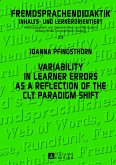- Gebundenes Buch
- Merkliste
- Auf die Merkliste
- Bewerten Bewerten
- Teilen
- Produkt teilen
- Produkterinnerung
- Produkterinnerung
This is a book about school safety and disaster readiness.
Andere Kunden interessierten sich auch für
![Redefining School Safety and Policing Redefining School Safety and Policing]() Jeffrey D. YarbroughRedefining School Safety and Policing203,99 €
Jeffrey D. YarbroughRedefining School Safety and Policing203,99 €![The Impact of Instructional Programs The Impact of Instructional Programs]() Avishan KeshavarzThe Impact of Instructional Programs28,99 €
Avishan KeshavarzThe Impact of Instructional Programs28,99 €![Student Misconceptions and Errors in Physics and Mathematics Student Misconceptions and Errors in Physics and Mathematics]() Teresa NeidorfStudent Misconceptions and Errors in Physics and Mathematics41,99 €
Teresa NeidorfStudent Misconceptions and Errors in Physics and Mathematics41,99 €![Student Misconceptions and Errors in Physics and Mathematics Student Misconceptions and Errors in Physics and Mathematics]() Teresa NeidorfStudent Misconceptions and Errors in Physics and Mathematics41,99 €
Teresa NeidorfStudent Misconceptions and Errors in Physics and Mathematics41,99 €![Variability in Learner Errors as a Reflection of the CLT Paradigm Shift Variability in Learner Errors as a Reflection of the CLT Paradigm Shift]() Joanna PfingsthornVariability in Learner Errors as a Reflection of the CLT Paradigm Shift71,80 €
Joanna PfingsthornVariability in Learner Errors as a Reflection of the CLT Paradigm Shift71,80 €![Why School Reform Is Failing and What We Need to Do about It Why School Reform Is Failing and What We Need to Do about It]() Jerry WartgowWhy School Reform Is Failing and What We Need to Do about It68,99 €
Jerry WartgowWhy School Reform Is Failing and What We Need to Do about It68,99 €![Screwed-Up School Reform Screwed-Up School Reform]() Bruce S. CooperScrewed-Up School Reform47,99 €
Bruce S. CooperScrewed-Up School Reform47,99 €-
-
Produktdetails
- Produktdetails
- Verlag: Globe Pequot Publishing Group Inc/Bloomsbury
- Seitenzahl: 204
- Erscheinungstermin: 7. August 2019
- Englisch
- Abmessung: 235mm x 157mm x 17mm
- Gewicht: 489g
- ISBN-13: 9781475837445
- ISBN-10: 1475837445
- Artikelnr.: 55489586
- Herstellerkennzeichnung
- Libri GmbH
- Europaallee 1
- 36244 Bad Hersfeld
- gpsr@libri.de
- Verlag: Globe Pequot Publishing Group Inc/Bloomsbury
- Seitenzahl: 204
- Erscheinungstermin: 7. August 2019
- Englisch
- Abmessung: 235mm x 157mm x 17mm
- Gewicht: 489g
- ISBN-13: 9781475837445
- ISBN-10: 1475837445
- Artikelnr.: 55489586
- Herstellerkennzeichnung
- Libri GmbH
- Europaallee 1
- 36244 Bad Hersfeld
- gpsr@libri.de
By David P. Perrodin - Foreword by Danny Woodburn
Foreword by Danny Woodburn Preface Acknowledgements Introduction Part One:
The Torus Chapter One: How Thinking About a Bagel Can Get You Through the
Worst Day of Your Life Chapter Two: Exploration Is a Kind of Safety Drill
Chapter Three: Situational Awareness via Sensemaking, Your Sword and Shield
Chapter Four: Legacy Knowledge Part Two: The Foolishness of Benchmarking
Chapter Five: Disasters Are the Real Snowflakes Chapter Six: Another New
Latin Word: Psychological Transference Chapter Seven: So, What's Wrong with
Benchmarking? Critical Decision-Making in a Nonlinear World Chapter Eight:
Why Comparing Disasters Feels Too Good to Be True Chapter Nine: One
Variable, One Very Big Difference: the Internet Chapter Ten: A Final Word
on Schools and Benchmarking Part Three: Drill Fidelity Chapter Eleven:
Fancy Drills Are Worse Than Useless Chapter Twelve: The Right Way to
Conduct a Drill: Critical Decision Making in a Nonlinear World Chapter
Thirteen: Other Options: Tabletop Exercises and Focus Groups Chapter
Fourteen: What is a Tabletop Exercise? Chapter Fifteen: Video Boondoggle
Chapter Sixteen: One More Don't: Professional Standards for Educational
Leaders (PSEL) Part Four: Systems Will Develop, So Let Them Chapter
Seventeen: The Zen of Safety Chapter Eighteen: Incident Command Structure
Chapter Nineteen: Tornadoes, Hurricanes, and the Fabulous Cajun Navy Relief
Chapter Twenty: Seeing Faces on the Moon: How Pareidolia Helped the Rescue
System on 9/11 Develop Chapter Twenty-One: Transitioning into Chaos - How
Increasing the "Noise" Increases Options... Up to a Point Chapter
Twenty-Two: Hobbes's Leviathan Meets the Twin Towers Part Five: How We Know
What We Know. So Why Do These Systems Develop? Chapter Twenty-Three:
Simulated Annealing, or SA: How the Human Brain is Specialized for
Improvisation Chapter Twenty-Four: Leadership Theories AH (After Hobbes)
Chapter Twenty-Five: Legacy Knowledge, Distributed Leadership, and Rookie
Teachers vs. Admiral Loy Chapter Twenty-Six: Summary of What We Know Part
Six: The Future Chapter Twenty-Seven: How Will Decisions Made in the Moment
Be Studied? And How Will Future Decisions Be Directed? Chapter
Twenty-Eight: Bollards and Planters: The Terrible Ideas That Are Coming to
a School Near You Chapter Twenty-Nine: A Mile Wide and an Inch Deep Chapter
Thirty: Final Implications for School Leaders Epilogue: Nothing Means
Anything To Anyone Until It Means Everything To You References Index Meet
the Author
The Torus Chapter One: How Thinking About a Bagel Can Get You Through the
Worst Day of Your Life Chapter Two: Exploration Is a Kind of Safety Drill
Chapter Three: Situational Awareness via Sensemaking, Your Sword and Shield
Chapter Four: Legacy Knowledge Part Two: The Foolishness of Benchmarking
Chapter Five: Disasters Are the Real Snowflakes Chapter Six: Another New
Latin Word: Psychological Transference Chapter Seven: So, What's Wrong with
Benchmarking? Critical Decision-Making in a Nonlinear World Chapter Eight:
Why Comparing Disasters Feels Too Good to Be True Chapter Nine: One
Variable, One Very Big Difference: the Internet Chapter Ten: A Final Word
on Schools and Benchmarking Part Three: Drill Fidelity Chapter Eleven:
Fancy Drills Are Worse Than Useless Chapter Twelve: The Right Way to
Conduct a Drill: Critical Decision Making in a Nonlinear World Chapter
Thirteen: Other Options: Tabletop Exercises and Focus Groups Chapter
Fourteen: What is a Tabletop Exercise? Chapter Fifteen: Video Boondoggle
Chapter Sixteen: One More Don't: Professional Standards for Educational
Leaders (PSEL) Part Four: Systems Will Develop, So Let Them Chapter
Seventeen: The Zen of Safety Chapter Eighteen: Incident Command Structure
Chapter Nineteen: Tornadoes, Hurricanes, and the Fabulous Cajun Navy Relief
Chapter Twenty: Seeing Faces on the Moon: How Pareidolia Helped the Rescue
System on 9/11 Develop Chapter Twenty-One: Transitioning into Chaos - How
Increasing the "Noise" Increases Options... Up to a Point Chapter
Twenty-Two: Hobbes's Leviathan Meets the Twin Towers Part Five: How We Know
What We Know. So Why Do These Systems Develop? Chapter Twenty-Three:
Simulated Annealing, or SA: How the Human Brain is Specialized for
Improvisation Chapter Twenty-Four: Leadership Theories AH (After Hobbes)
Chapter Twenty-Five: Legacy Knowledge, Distributed Leadership, and Rookie
Teachers vs. Admiral Loy Chapter Twenty-Six: Summary of What We Know Part
Six: The Future Chapter Twenty-Seven: How Will Decisions Made in the Moment
Be Studied? And How Will Future Decisions Be Directed? Chapter
Twenty-Eight: Bollards and Planters: The Terrible Ideas That Are Coming to
a School Near You Chapter Twenty-Nine: A Mile Wide and an Inch Deep Chapter
Thirty: Final Implications for School Leaders Epilogue: Nothing Means
Anything To Anyone Until It Means Everything To You References Index Meet
the Author
Foreword by Danny Woodburn Preface Acknowledgements Introduction Part One:
The Torus Chapter One: How Thinking About a Bagel Can Get You Through the
Worst Day of Your Life Chapter Two: Exploration Is a Kind of Safety Drill
Chapter Three: Situational Awareness via Sensemaking, Your Sword and Shield
Chapter Four: Legacy Knowledge Part Two: The Foolishness of Benchmarking
Chapter Five: Disasters Are the Real Snowflakes Chapter Six: Another New
Latin Word: Psychological Transference Chapter Seven: So, What's Wrong with
Benchmarking? Critical Decision-Making in a Nonlinear World Chapter Eight:
Why Comparing Disasters Feels Too Good to Be True Chapter Nine: One
Variable, One Very Big Difference: the Internet Chapter Ten: A Final Word
on Schools and Benchmarking Part Three: Drill Fidelity Chapter Eleven:
Fancy Drills Are Worse Than Useless Chapter Twelve: The Right Way to
Conduct a Drill: Critical Decision Making in a Nonlinear World Chapter
Thirteen: Other Options: Tabletop Exercises and Focus Groups Chapter
Fourteen: What is a Tabletop Exercise? Chapter Fifteen: Video Boondoggle
Chapter Sixteen: One More Don't: Professional Standards for Educational
Leaders (PSEL) Part Four: Systems Will Develop, So Let Them Chapter
Seventeen: The Zen of Safety Chapter Eighteen: Incident Command Structure
Chapter Nineteen: Tornadoes, Hurricanes, and the Fabulous Cajun Navy Relief
Chapter Twenty: Seeing Faces on the Moon: How Pareidolia Helped the Rescue
System on 9/11 Develop Chapter Twenty-One: Transitioning into Chaos - How
Increasing the "Noise" Increases Options... Up to a Point Chapter
Twenty-Two: Hobbes's Leviathan Meets the Twin Towers Part Five: How We Know
What We Know. So Why Do These Systems Develop? Chapter Twenty-Three:
Simulated Annealing, or SA: How the Human Brain is Specialized for
Improvisation Chapter Twenty-Four: Leadership Theories AH (After Hobbes)
Chapter Twenty-Five: Legacy Knowledge, Distributed Leadership, and Rookie
Teachers vs. Admiral Loy Chapter Twenty-Six: Summary of What We Know Part
Six: The Future Chapter Twenty-Seven: How Will Decisions Made in the Moment
Be Studied? And How Will Future Decisions Be Directed? Chapter
Twenty-Eight: Bollards and Planters: The Terrible Ideas That Are Coming to
a School Near You Chapter Twenty-Nine: A Mile Wide and an Inch Deep Chapter
Thirty: Final Implications for School Leaders Epilogue: Nothing Means
Anything To Anyone Until It Means Everything To You References Index Meet
the Author
The Torus Chapter One: How Thinking About a Bagel Can Get You Through the
Worst Day of Your Life Chapter Two: Exploration Is a Kind of Safety Drill
Chapter Three: Situational Awareness via Sensemaking, Your Sword and Shield
Chapter Four: Legacy Knowledge Part Two: The Foolishness of Benchmarking
Chapter Five: Disasters Are the Real Snowflakes Chapter Six: Another New
Latin Word: Psychological Transference Chapter Seven: So, What's Wrong with
Benchmarking? Critical Decision-Making in a Nonlinear World Chapter Eight:
Why Comparing Disasters Feels Too Good to Be True Chapter Nine: One
Variable, One Very Big Difference: the Internet Chapter Ten: A Final Word
on Schools and Benchmarking Part Three: Drill Fidelity Chapter Eleven:
Fancy Drills Are Worse Than Useless Chapter Twelve: The Right Way to
Conduct a Drill: Critical Decision Making in a Nonlinear World Chapter
Thirteen: Other Options: Tabletop Exercises and Focus Groups Chapter
Fourteen: What is a Tabletop Exercise? Chapter Fifteen: Video Boondoggle
Chapter Sixteen: One More Don't: Professional Standards for Educational
Leaders (PSEL) Part Four: Systems Will Develop, So Let Them Chapter
Seventeen: The Zen of Safety Chapter Eighteen: Incident Command Structure
Chapter Nineteen: Tornadoes, Hurricanes, and the Fabulous Cajun Navy Relief
Chapter Twenty: Seeing Faces on the Moon: How Pareidolia Helped the Rescue
System on 9/11 Develop Chapter Twenty-One: Transitioning into Chaos - How
Increasing the "Noise" Increases Options... Up to a Point Chapter
Twenty-Two: Hobbes's Leviathan Meets the Twin Towers Part Five: How We Know
What We Know. So Why Do These Systems Develop? Chapter Twenty-Three:
Simulated Annealing, or SA: How the Human Brain is Specialized for
Improvisation Chapter Twenty-Four: Leadership Theories AH (After Hobbes)
Chapter Twenty-Five: Legacy Knowledge, Distributed Leadership, and Rookie
Teachers vs. Admiral Loy Chapter Twenty-Six: Summary of What We Know Part
Six: The Future Chapter Twenty-Seven: How Will Decisions Made in the Moment
Be Studied? And How Will Future Decisions Be Directed? Chapter
Twenty-Eight: Bollards and Planters: The Terrible Ideas That Are Coming to
a School Near You Chapter Twenty-Nine: A Mile Wide and an Inch Deep Chapter
Thirty: Final Implications for School Leaders Epilogue: Nothing Means
Anything To Anyone Until It Means Everything To You References Index Meet
the Author








